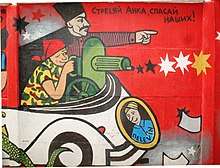Chapayev and Void
Chapayev and Pustota (Russian: «Чапаев и Пустота»), known in the US as Buddha's Little Finger and in the UK as Clay Machine Gun, is a novel by Victor Pelevin first published in 1996. A film adaption, Buddha's Little Finger by Tony Pemberton, was released in 2015.
Plot summary

The novel is written as a first-person narrative of Pyotr Pustota (English: Pyotr Void) and in the introduction to this book it is claimed that unlike Dmitriy Furmanov's book Chapayev, this book is the truth.
The book is set in two different times — after the October Revolution and in modern Russia. In the post-revolutionary period, Pyotr Pustota is a poet who has fled from Saint Petersburg to Moscow and who takes up the identity of a Soviet political commissar and meets a strange man named Vasily Chapayev who is some sort of an army commander. He spends his days drinking samogon, taking drugs and talking about the meaning of life with Chapayev.
Every night (according to his post-revolutionary life) Pustota has nightmares about him being locked up in a psychiatric hospital because of his beliefs of being a poet from the beginning of the century. He shares the room in the hospital with three other men, each with his very individual form of fake identity.
Until the end of the book it isn't perfectly clear, which of Pyotr's identities is the real one and whether there is such a thing as a real identity at all.
Characters
Revolutionary period
Pyotr
Pyotr is an unpolitical monarchist poet who is fleeing from the authorities. After murdering his former schoolmate chekist commander von Ernen he takes up von Ernen's checkist name Fanerny. Apartment he meets Chapayev and after a revolutionary performance which Pyotr does in a cabaret as Fanerny he is approached by Chapayev. Chapayev tells him that Pyotr (or Fanerny) is transferred to the Asian Cavalry division which is commanded by Chapayev. Everything that happens to him after boarding a train with Chapayev and his niece Anna is lost from Pyotr's memory after an injury he suffers in battle. Later he learns from other characters that he had become really close with Chapayev and had found answers to many questions. Pyotr falls in love with Anna who doesn't seem to find him attractive or interesting. He spends much time talking to Chapayev who is trying to explain the illusionary nature of the world to Pyotr. Pyotr's character is based on Pyotr Semenovich Isayev who was Chapayev's assistant in real life.
Chapayev
Anna
Kotovski
Baron Ungern
Furmanov
von Ernen
Modern Russia
Pyotr
In modern Russia Pyotr wakes up in a psychiatric hospital and has only Pyotr's memories from the times of the revolution. From his case in the hospital he learns to know that he has had psychological pathologies since the age of fourteen.
Serdyuk
Semen Serdyuk is an inmate of the 17th psychiatric hospital who shares the room with Pyotr. He claims that he has been put in the hospital after a misunderstanding he had with some policeman over the illusionarity of the world while lying drunk in some basement. When he is put in a state similar to hypnosis he tells a different story - about himself applying for work in a Japanese firm and performing seppuku when the company that has hired him becomes a subject of a hostile takeover by an archrival company.
Volodin
Vladimir Volodin is a Russian gangster (so-called "New Russian") and Pyotr's fellow inmate. He and his two friends (or rather "business partners") had consumed numerous psychedelic mushrooms, which took them to a Valhalla-like place ruled by Baron Sternberg.
Maria
Maria or Simply Maria (a male character) is another roommate of Pyotr's in the psychiatric hospital. After a head injury he has partly taken up the identity of "Simply Maria" - a character played by Victoria Ruffo in the soap opera Simplemente María which was very popular in Russia in the 1990s. In his hallucinations he is a manly woman who meets Arnold Schwarzenegger and after flying together with him on a military airplane through Moscow Maria is hit by the Ostankino Tower. His fantasies are full of phallic symbols.
Timur Timurovich
References
- Text on V.Pelevin web-site (in Russian)
- Bibliographic information